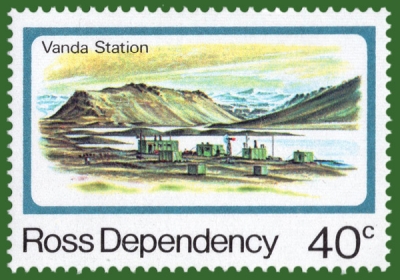-
Life in Antarctica
Ross Dependency 1982.01.20
In issue: Stamp(s): 6
Printing: multicoloral offset
-
Number by catalogue: Michel: NZ-RO 19 Yvert: NZ-RO 19 Gibbons: NZ-RO 19
Perforation type: 15 ½x15 ½
Subject:
40 New Zealand cents.
Antarctic Vanda Station*.
On a fragment of the stamp, you can well see a small wind generator.Additional:
The Ross Dependency is a region of Antarctica defined by a sector originating at the South Pole, passing along longitudes 160 ° east to 150 ° west, and terminating at latitude 60 ° south. It is claimed by New Zealand. Since the Antarctic Treaty came into force in 1961, Article IV of which states: "No acts or activities taking place while the present Treaty is in force shall constitute a basis for asserting, supporting or denying a claim to territorial sovereignty in Antarctica or create any rights of sovereignty in Antarctica ", most countries do not recognize territorial claims in Antarctica.
The Dependency takes its name from Sir James Clark Ross, who discovered the Ross Sea, and includes part of Victoria Land, and most of the Ross Ice Shelf. Ross Island, Balleny Islands and the small Scott Island also form part of the Dependency, as does the ice-covered Roosevelt Island.
*From 1969 to 1995 New Zealand operated a summer-only base called Vanda Station in the Dry Valley area of the Dependency.
Vanda Station was an Antarctic research base in the western highlands (Victoria Land) of the Ross Dependency, specifically on the shore of Lake Vanda, at the mouth of Onyx River, in the Wright Valley. The four original station buildings were constructed in the austral summers of 1967–1968 and 1968–1969, just prior to the first winter-over by a five-man team from January to October 19, 1969. Subsequent wintering parties occupied the station in 1970 and 1974. During summer seasons, Vanda station was fully staffed until 1991. Scientific programs principally included meteorology, hydrology, seismology, earth currents, and magnetics. The station was administered by the Department of Scientific and Industrial Research (DSIR), and was supported logistically by the permanent New Zealand research base of Scott Base on Ross Island.
Vanda Station was well known for The Royal Lake Vanda Swim Club. Visitors to Lake Vanda Station could dip into the high salinity waters when the icecap edge melted out during summer to form a "moat", and receive a Royal Lake Vanda Swim Club shoulder patch. Vanda staff would assist the melt by hacking out a "pool". Many dignitaries and politicians were inducted into the club, The dip had to be naked (Rule 1), complete immersion (Rule 4), witnessed by a "Vandal" (Vanda Station staffer) and with no restrictions on photography (Rule 6) to qualify. Rule 10 allowed a natural figleaf, but it had to be natural and also naturally green without artificial aid.
In 1995, environment concerns resulted in the base being closed. Various activities associated with the base's occupation, including excavations, the erection of buildings, disturbances caused by vehicle movements, the storage of consumables, waste disposal, and accidental spills, led to the effort to remove the station. Since removal, analysis of the lake water and algae was performed for a number of years to ensure the lake was not contaminated by greywater and other wastes.
Vanda Station is the location of the highest temperature ever recorded in Antarctica, which was 59 °F (15 °C) on January 5, 1974.
Today, an automatic weather station is at the site of former Vanda Station, and Lake Vanda Hut, a shelter that is periodically (summer only) occupied by 2 to 8 New Zealand stream researchers.
__________
This information has been taken from Wikipedia and Antarctica NZ Digital Asset Manager web page
Topics: Wind turbines



